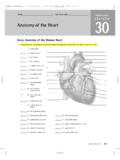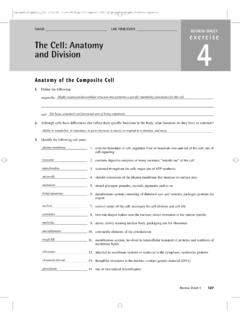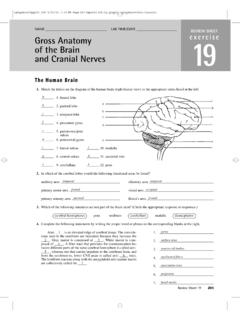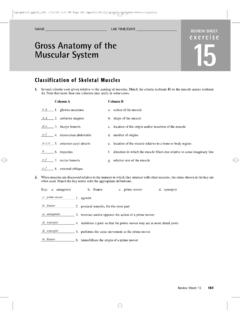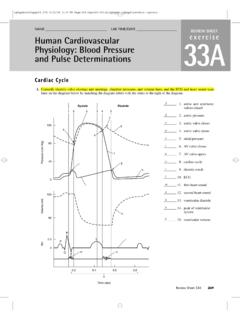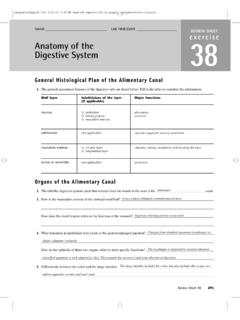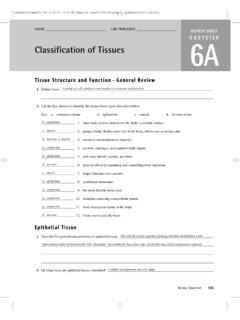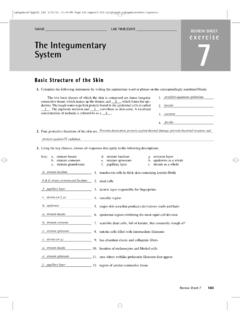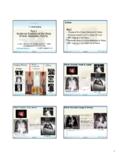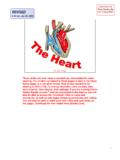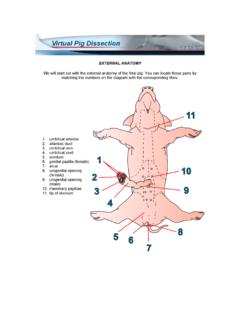Transcription of The Language of Anatomy - apchute.com
1 REVIEW SHEET exercise1 The Language of AnatomyReview Sheet 1115 Surface each of the following descriptions with a key equivalent, and record the key letter or term in front of the :a. buccalc. cephalice. patellarb. calcaneald. digitalf. scapular1. cheek4. anterior aspect of knee2. pertaining to the fingers5. heel of foot3. shoulder blade region6. pertaining to the the following body areas on the accompanying diagram by placing the correct key letter at the end of each each of the terms in the key of question 2 above into one of the large body regions indicated below.
2 Insert the ap-propriate key letters on the answer Appendicular2. AxialNAME _____LAB TIME/DATE _____NAME _____LAB TIME/DATE _____a; buccale; patellard; digitalb; calcanealf; scapularc; cephalicb, c, d, f, g, h, n, pa, e, i, j, k, l, m, o, q, ramqebjorghfpnikdclighapmLre01pg115_120 5/12/04 12:35 PM Page 115 impos03 302:bjighapmL:ighapmLrevshts:layouts:Bod y Orientation, Direction, Planes, and completely the standard human anatomical position. incomplete statements are listed below. Correctly complete each statement by choosing the appropriate anatomicalterm from the key.
3 Record the key letters and/or terms on the correspondingly numbered blanks :a. anteriord. inferiorg. posteriorj. superiorb. distale. lateralh. proximalk. transversec. frontalf. mediali. sagittalIn the anatomical position, the face and palms are on the 1body surface; the buttocks and shoulder blades are onthe 2body surface; and the top of the head is the most 3part of the body. The ears are 4and5to theshoulders and 6to the nose. The heart is 7to the vertebral column (spine) and 8to the lungs. The elbow is 9to the fingers but 10to the shoulder.
4 The abdominopelvic cavity is 11to the thoracic cavity and 12tothe spinal cavity. In humans, the dorsal surface can also be called the 13surface; however, in quadruped animals, thedorsal surface is the an incision cuts the heart into right and left parts, the section is a 15section; but if the heart is cut so that su-perior and inferior portions result, the section is a 16section. You are told to cut a dissection animal along two planesso that the kidneys are observable in both sections. The two sections that meet this requirement are the17and 18sections.
5 A section that demonstrates the continuity between the spinal and cranial cavities is a identify each of the body planes by inserting the appropriate term for each on the answer line below the drawing.(a)(b)(c)116 Review Sheet 1 Standing erect, feet together, head and toes pointedforward, arms hanging at sides with palms cut made along a body ; anteriorf; medialj; superiorg; posteriorh; proximali; sagittalj; superiorb; distalk; transversef; mediald; inferiorc; frontalj; superiora; anteriork; transversee; lateralg; posteriori; sagittala.
6 Anteriormedian (mid-sagittal) planefrontal planetransverse planeighapmLre01pg115_120 5/12/04 12:35 PM Page 116 impos03 302:bjighapmL:ighapmLrevshts: a kidney as it would appear sectioned in three different identify each of the nine areas of the abdominal surface by inserting the appropriate termfor each of the letters indicated in the body cavity would have to be opened for the following types of surgery? (Insert letter of key choice in same-numbered blank. More than one choice may apply.)Key:a. abdominopelvicc. dorsale. thoracicb. craniald.
7 Spinalf. to remove a cancerous lung of the uterus or ulcer of a brain of pre-operative saddle the muscle that subdivides the ventral body cavity. (a)(c)(d)(f)(g)(i)(b)(e)(h)frontal sectionsagittal sectiontransverse sectionReview Sheet 1117epigastric regionright hypochondriac regionleft hypochondriac regionumbilical regionright lumbar regionleft lumbar regionhypogastric (pubic) regionright iliac regionleft iliac 5/12/04 12:35 PM Page 117 impos03 302:bjighapmL:ighapmLrevshts: organ system would not be represented in any of the body cavities?
8 Are the bony landmarks of the abdominopelvic cavity? body cavity affords the least protection to its internal structures? is the function of the serous membranes of the body? nurse informs you that she is about to take blood from the antecubital region. What portion of your body should you pre-sent to her? mouth, or oral cavity, and its extension, which stretches through the body to the anus, is not listed as an internal bodycavity. Why is this so? the key choices, identify the small body cavities described :a. middle ear cavityc. oral cavitye.
9 Synovial cavityb. nasal cavityd. orbital cavity1. holds the eyes in an anterior-facing position2. contains the tongue3. lines a joint cavity4. houses three tiny bones involved in hearing5. contained within the the incomplete flow chart provided below: Fill in the cavity names as appropriate to each box. Then, using either the box numbers or the name of the cavity, identify the descriptions on the following page. (Somemay require more than one choice.)118 Review Sheet 1 Skeletal, muscular, integumentaryDorsally, the vertebral column; laterally and anteriorly, the pelvisAbdominalThe serous membranes produce a lubricating fluid that reduces friction as organs slide across one another or against the cavity walls during their arm (the anterior surface of the elbow joint).
10 The cavity (lumen) of this digestive tube is continuous with the external dorsalbody cavity2 cranialcavity3 spinalcavity4 ventralbody cavity5 thoraciccavity6 abdominopelviccavity7 abdominalcavity8 pelviccavityBody cavitiesd; orbital cavityc; oral cavitye; synovial cavitya; middle ear cavityb; nasal cavityighapmLre01pg115_120 5/12/04 12:35 PM Page 118 impos03 302:bjighapmL:ighapmLrevshts:layouts:a. contained within the skull and vertebral columnb. contains female reproductive organsc. the most protective body cavityd. its name means bellye.
